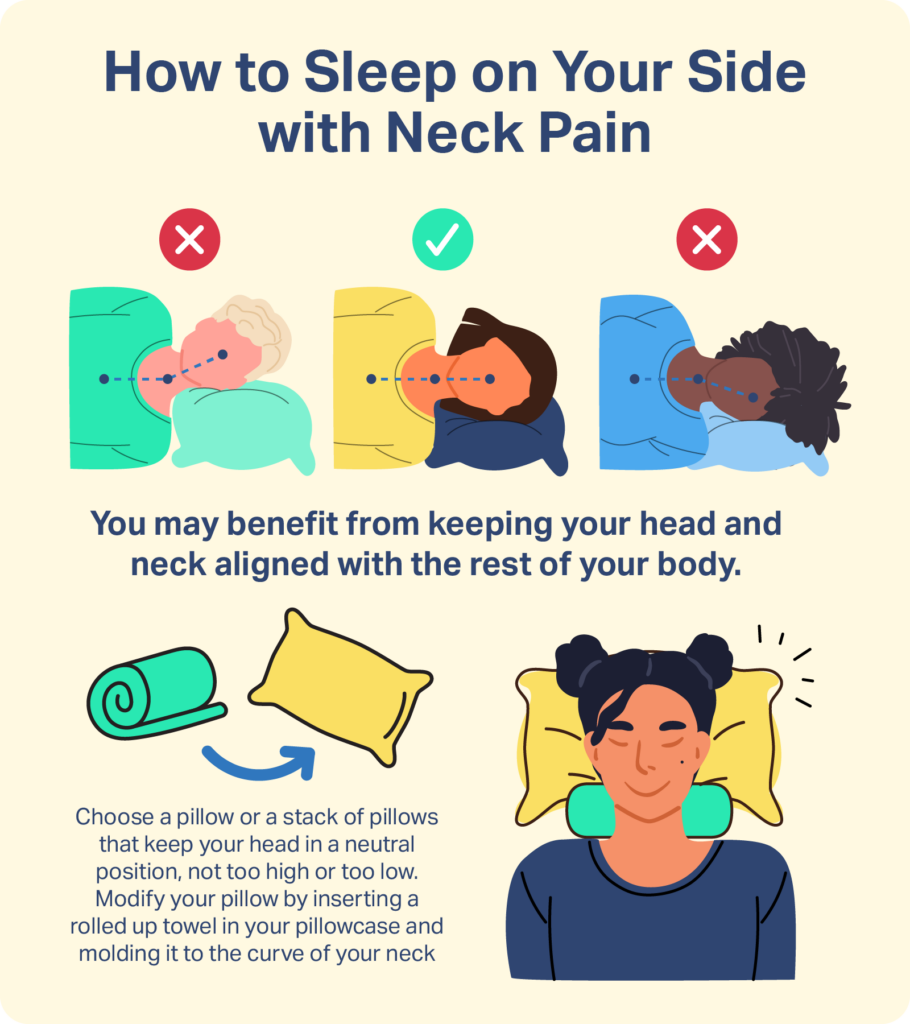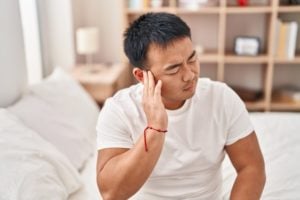How to Choose the Best Sleeping Position for Neck Pain
- The best sleeping positions for neck pain are side sleeping and back sleeping.
- Avoid stomach sleeping, which can strain your neck.
- Daytime posture, stress, and physical activity can also build up tension in the neck.
- Use a supportive pillow that keeps your neck aligned with your spine.
Pain can make it difficult to fall and stay asleep , and neck pain is no exception. Nearly 10% of people have neck pain and approximately 70% of people with chronic neck pain experience poor quality sleep. Research shows that certain sleeping positions can trigger neck pain and contribute to lower sleep quality.
Quality sleep is essential for a healthy body and mind. Physical and mental health, immune function, and thinking are all impacted by a lack of sleep. To experience the full benefits of sleep, experts recommend that most adults get at least seven hours of sleep each night.
By sleeping in a supported position, people with neck pain may find relief and get the quality sleep they need. We highlight the best sleeping positions for neck pain, as well as potential causes of nighttime discomfort and tips for getting a better night’s rest.
Side Sleeping
Studies suggest that a majority of adults sleep on their side. Side sleeping may lower the risk of pain in the spine and neck and may provide other benefits like reduced snoring and acid reflux.
How to Sleep on Your Side with Neck Pain
To help prevent stiffness in the neck muscles, side sleepers should keep their head and neck aligned with the rest of their body. This alignment can prevent excess weight from being placed on the neck and causing discomfort.
To achieve proper alignment, side sleepers can choose pillows that keep the head in a neutral position. For some side sleepers, a larger pillow or stack of pillows can prevent the head from sinking too far toward the mattress and triggering neck pain. However, side sleepers may want to avoid pillows or stacks of pillows that are too thick. Excessive pillows can elevate the head and neck too much, which can also lead to neck pain.

Side sleepers can also modify their current pillows for support. One strategy is to roll up a hand towel and insert it along the long edge of the pillowcase. The shape of a rolled towel can be changed to fit the natural curve of the neck and fill the space between the side of the face and the shoulder.
After arranging pillows for support, side sleepers can test to see if the combination aligns the head and neck with the rest of the body. One way to check for proper alignment is to take a picture of the sleeper lying on their pillows, then determine if their neck is in line or if the pillows need further adjustment.
Back Sleeping
Back sleeping is the second most common sleep position among adults and is often recommended for people with spinal pain. Back sleeping with proper head and neck alignment may help decrease pain in the neck.
How to Sleep on Your Back with Neck Pain
Back sleepers may find relief from neck pain by adjusting their position with a few pillows. A small pillow at the base of the neck can keep the head in a neutral position, while placing a pillow beneath the knees or thighs can keep the muscles along the spine flat and relax muscles in the neck.
Another consideration for back sleepers is the placement of their hands during sleep. Research suggests that certain hand positions can activate muscles in the upper back and neck, causing the body to rotate and move the spine out of proper alignment. Back sleeping with the hands to the side or on the chest may reduce neck and back pain.
Worst Sleeping Position for Neck Pain
Stomach sleeping with the head facing one side is not recommended for relieving neck pain. Sleeping on the stomach may increase weight on the neck and limit recovery from pain. Compared to side and back sleepers, stomach sleepers report the greatest amount of neck pain during the day.
Stomach sleepers may be able to train themselves to sleep on their back or side to reduce neck pain. One way to change a habitual sleep position is to place pillows around the body to prevent turning onto the stomach until the new sleep position is established.
Causes of Neck Pain During Sleep
Common sleep habits and daytime activities can strain or cause tension in the neck muscles and lead to neck pain.
- Poor support: Insufficient support during sleep can trigger pain in the neck and other areas of the spine.
- Sleep position: Some sleep positions, such as stomach sleeping, can cause neck pain.
- Poor posture: Looking up or down at a computer screen, sitting too long in one position, and carrying heavy bags or purses can all affect the neck and upper back muscles.
- Stress: Tension in the neck can arise from psychological stress. Stress can also slow down recovery from pain.
Tips for Sleeping with Neck Pain
In addition to adjusting their sleep position for better alignment, sleepers with neck pain can make small changes to their sleep spaces and incorporate new steps into their daytime routines.
Replace Old Mattresses or Pillows
For some people with neck pain, a firmer mattress can help support the neck during sleep. Special neck pillows can also provide additional support.
Apply Heat and Cold
Some people with neck pain find relief by applying heat or cold to the painful area before bedtime. Experts recommend using this approach for a maximum of 15 minutes each session. To protect the skin, use a heating pad on a low setting or an ice pack wrapped in a towel. People should be sure to stay awake when using heat or cold to avoid potential injury.
Modify Posture
Daytime posture, such as hunching over a desk, can contribute to neck pain and tension. Small adjustments, such as sitting up straight with the chin tilted down as little as possible, can help train the body to adopt a more neutral posture.
Exercise and Stretch
Neck stretches and rotations, shoulder rolls, and other gentle exercises can help relieve neck pain and prevent the pain from recurring. If possible, these movements can be performed daily. A physical therapist or other health care provider can recommend targeted exercises to meet an individual’s needs.
Reduce Stress
Meditation and mindful breathing techniques may relieve stress and prevent tension in the neck. Gentle forms of exercise such as yoga and tai chi can also help with relaxation. Some people may find it helpful to consult a psychologist or other mental health professional who teaches strategies for managing stress and pain.
Consider Pain Relievers
Both non-steroidal anti-inflammatory drugs (NSAIDs) and acetaminophen are often recommended by health care professionals for treating neck pain. However, like all drugs, these medications have risks, so it may help to speak with your doctor about pain-relieving medication. Your doctor can also help you explore prescription medications if over-the-counter drugs do not provide enough pain relief.
Wear a Neck Brace
A soft brace worn around the neck can relieve pain and keep the neck from moving. Neck braces can be worn occasionally while sleeping if the neck pain disrupts sleep. However, use of neck braces during the day should be limited to three hours for no more than two weeks to avoid delaying recovery.
When to Talk to Your Doctor About Neck Pain
Neck pain is a common problem with possible causes . In most cases, people with neck pain recover after limited treatment. However, you should inform your health care provider as soon as possible if you experience any of the following symptoms along with neck pain:
- Fever
- Headache
- Weakness in the legs
- Unexpected weight loss
- Sweating
- Shortness of breath
- Nausea
- Pain in the arm or jaw
- Neck stiffness and immobility
References
14 Sources
-
Lubit, R. H., & Bonds, C. L. (2019, August 21). Sleep-wake disorders. Medscape.
https://emedicine.medscape.com/article/287104-overview -
Isaac, Z. (2021, November 16). Management of non-radicular neck pain in adults. In S.J. Atlas (Ed.). UpToDate.
https://www.uptodate.com/contents/management-of-non-radicular-neck-pain-in-adults -
Cary, D., Jacques, A., & Briffa, K. (2021). Examining relationships between sleep posture, waking spinal symptoms and quality of sleep: A cross sectional study. PLoS One, 16(11), e0260582.
https://pubmed.ncbi.nlm.nih.gov/34847195/ -
Maski, K. (2021, February 19). Insufficient sleep: Evaluation and management. In T. E. Scammell (Ed.). UpToDate., Retrieved April 20, 2022, from
https://www.uptodate.com/contents/insufficient-sleep-evaluation-and-management -
Consensus Conference Panel, Watson, N. F., Badr, M. S., Belenky, G., Bliwise, D. L., Buxton, O. M., Buysse, D., Dinges, D. F., Gangwisch, J., Grandner, M. A., Kushida, C., Malhotra, R. K., Martin, J. L., Patel, S. R., Quan, S. F., Tasali, E., Non-Participating Observers, Twery, M., Croft, J. B., Maher, E., … Heald, J. L. (2015). Recommended amount of sleep for a healthy adult: A joint consensus statement of the American Academy of Sleep Medicine and Sleep Research Society. Journal of Clinical Sleep Medicine, 11(6), 591–592.
https://pubmed.ncbi.nlm.nih.gov/25979105/ -
Skarpsno, E. S., Mork, P. J., Nilsen, T. I. L., & Holtermann, A. (2017). Sleep positions and nocturnal body movements based on free-living accelerometer recordings: Association with demographics, lifestyle, and insomnia symptoms. Nature and Science of Sleep, 9, 267–275.
https://pubmed.ncbi.nlm.nih.gov/29138608/ -
Cary, D., Briffa, K., & McKenna, L. (2019). Identifying relationships between sleep posture and non-specific spinal symptoms in adults: A scoping review. BMJ Open, 9(6), e027633.
https://pubmed.ncbi.nlm.nih.gov/31256029/ -
Ravesloot, M. J., van Maanen, J. P., Dun, L., & de Vries, N. (2013). The undervalued potential of positional therapy in position-dependent snoring and obstructive sleep apnea: A review of the literature. Sleep & breathing, 17(1), 39–49.
https://pubmed.ncbi.nlm.nih.gov/22441662/ -
Khoury, R. M., Camacho-Lobato, L., Katz, P. O., Mohiuddin, M. A., & Castell, D. O. (1999). Influence of spontaneous sleep positions on nighttime recumbent reflux in patients with gastroesophageal reflux disease. The American journal of gastroenterology, 94(8), 2069–2073.
https://pubmed.ncbi.nlm.nih.gov/10445529/ -
Lee, W. H., & Ko, M. S. (2017). Effect of sleep posture on neck muscle activity. Journal of Physical Therapy Science, 29(6), 1021–1024.
https://pubmed.ncbi.nlm.nih.gov/28626314/ -
Isaac, Z., & Dec, K. L. (2020, September 3). Patient education: Neck pain (Beyond the basics). In J. G. Elmore (Ed.). UpToDate.
https://www.uptodate.com/contents/neck-pain-beyond-the-basics -
A.D.A.M. Medical Encyclopedia. (2022, April 1). Neck pain or spasms – self care. MedlinePlus., Retrieved April 20, 2022, from
https://medlineplus.gov/ency/patientinstructions/000802.htm -
Moley, P. J. (2020, November). Neck pain. Merck Manual Consumer Version., Retrieved April 20, 2022, from
https://www.merckmanuals.com/home/bone,-joint,-and-muscle-disorders/low-back-and-neck-pain/neck-pain -
Isaac, Z. & Kelly, H. R. (2021, March 16). Evaluation of the adult patient with neck pain. In S. J. Atlas (Ed.). UpToDate., Retrieved April 20, 2022, from
https://www.uptodate.com/contents/evaluation-of-the-adult-patient-with-neck-pain









